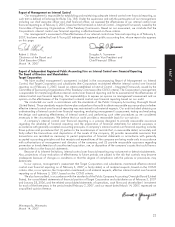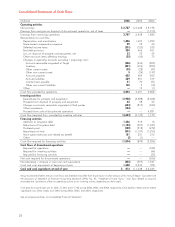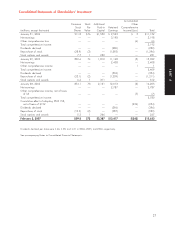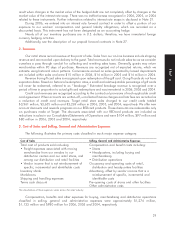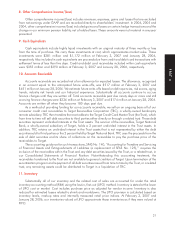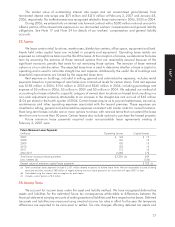Target 2006 Annual Report Download - page 48
Download and view the complete annual report
Please find page 48 of the 2006 Target annual report below. You can navigate through the pages in the report by either clicking on the pages listed below, or by using the keyword search tool below to find specific information within the annual report.
4. Consideration Received from Vendors
We receive consideration for a variety of vendor-sponsored programs, such as volume rebates,
markdown allowances, promotions and advertising and for our compliance programs, referred to as
‘‘vendor income.’’ Vendor income reduces either our inventory costs or selling, general and administrative
expenses based on the provisions of the arrangement. Promotional and advertising allowances are intended
to offset our costs of promoting and selling the vendor’s merchandise in our stores. Under our compliance
programs, vendors are charged for merchandise shipments that do not meet our requirements
(‘‘violations’’), such as late or incomplete shipments. These allowances are recorded when violations occur.
We establish a receivable for vendor income that is earned but not yet received. Based on provisions of
the agreements in place, this receivable is computed by estimating the point at which we have completed
our performance and the amount earned. We perform detailed analyses to determine the appropriate level
of the receivable in the aggregate. The majority of year-end receivables associated with these activities are
collected within the following fiscal quarter.
5. Advertising Costs
Advertising costs are expensed at first showing or distribution of the advertisement and were
$1,170 million, $1,028 million, and $888 million for 2006, 2005 and 2004, respectively. Advertising
vendor income that offset advertising expenses was approximately $118 million, $110 million, and
$72 million for 2006, 2005 and 2004, respectively. Newspaper circulars and media broadcast made up
the majority of our advertising costs in all three years.
6. Discontinued Operations
We completed the sale of our Marshall Field’s and Mervyn’s businesses during 2004, and the financial
results of Marshall Field’s and Mervyn’s are reported as discontinued operations. For 2004, total revenues
included in discontinued operations were $3,095 million, and earnings from discontinued operations were
$75 million, net of taxes of $46 million. In addition, we recorded a gain on the sale of discontinued
operations of $1,238 million, net of taxes of $761 million, during 2004. There were no assets or liabilities
of Marshall Field’s or Mervyn’s included in our Consolidated Statements of Financial Position at February 3,
2007 or January 28, 2006.
7. Earnings per Share
Basic earnings per share (EPS) is net earnings divided by the weighted average number of common
shares outstanding during the period. Diluted EPS includes the incremental shares assumed to be issued
upon the exercise of stock options and the incremental shares assumed to be issued under performance
share and restricted stock unit arrangements.
Basic EPS Diluted EPS
(millions, except per share data) 2006 2005 2004 2006 2005 2004
Net earnings $2,787 $2,408 $3,198 $2,787 $2,408 $3,198
Basic weighted average common shares
outstanding 861.9 882.0 903.8 861.9 882.0 903.8
Incremental stock options, performance
share units and restricted stock units ———6.7 7.2 8.3
Weighted average common shares
outstanding 861.9 882.0 903.8 868.6 889.2 912.1
Earnings per share $ 3.23 $ 2.73 $ 3.54 $ 3.21 $ 2.71 $ 3.51
For the 2006, 2005 and 2004 EPS computations, 1.8 million, 4.4 million and 1.0 million stock
options, respectively, were excluded from the calculation of weighted average shares for diluted EPS
because their effects were antidilutive.
30





